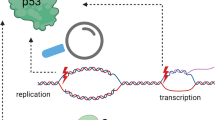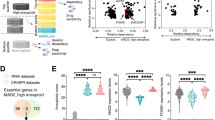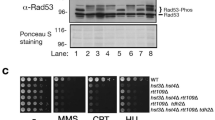Abstract
Since chromosomal instability (CIN) is a hallmark of most cancer cells, it is essential to identify genes whose alteration results into this genetic instability. Using a yeast CIN indicator strain, we show that inactivation of the YMR131c/RRB1 gene, which is involved in early ribosome assembly and whose expression is induced when the spindle checkpoint is activated, alters chromosome segregation and blocks mitosis at the metaphase/anaphase transition. We demonstrate that RRB1 interacts with YPH1 (yeast pescadillo homologue 1) and other members of the Yph1 complex, RPL3, ERB1 and ORC6, involved in ribosome biogenesis and DNA replication. Transient depletion of the human homologues GRWD, Pescadillo, Rpl3, Bop1 and Orc6L resulted in an increase of abnormal mitoses with appearance of binucleate or hyperploid cells, of cells with multipolar spindles and of aberrant metaphase plates. If deregulation of proteins involved in ribosome biogenesis, commonly observed in malignant tumors, could contribute to cancer through an aberrant protein synthesis, our study demonstrates that alteration of proteins linking ribosome biogenesis and DNA replication may directly cause CIN.
This is a preview of subscription content, access via your institution
Access options
Subscribe to this journal
Receive 50 print issues and online access
$259.00 per year
only $5.18 per issue
Buy this article
- Purchase on Springer Link
- Instant access to full article PDF
Prices may be subject to local taxes which are calculated during checkout






Similar content being viewed by others
References
Amon A . (1999). Curr. Opin. Genet. Dev., 9, 69–75.
Bergoglio V, Pillaire MJ, Lacroix-Triki M, Raynaud-Messina B, Canitrot Y, Bieth A, Gares M, Wright M, Delsol G, Loeb LA, Cazaux C and Hoffmann JS . (2002). Cancer Res., 62, 3511–3514.
Cahill DP, Lengauer C, Yu J, Riggins GJ, Willson JK, Markowitz SD, Kinzler KW and Vogelstein B . (1998). Nature, 392, 300–303.
Combet C, Blanchet C, Geourjon C and Deleage G . (2000). Trends Biochem. Sci., 25, 147–150.
Connelly C and Hieter P . (1996). Cell, 86, 275–285.
Dokal I and Luzzatto L . (1994). Leuk. Lymphoma, 15, 1–7.
Draptchinskaia N, Gustavsson P, Andersson B, Pettersson M, Willig TN, Dianzani I, Ball S, Tchernia G, Klar J, Matsson H, Tentler D, Mohandas N, Carlsson B and Dahl N . (1999). Nat. Genet., 21, 169–175.
Du YC and Stillman B . (2002). Cell, 109, 835–848.
Elbashir SM, Harborth J, Weber K and Tuschl T . (2002). Methods, 26, 199–213.
Gerring SL, Spencer F and Hieter P . (1990). EMBO J., 9, 4347–4358.
Heiss NS, Knight SW, Vulliamy TJ, Klauck SM, Wiemann S, Mason PJ, Poustka A and Dokal I . (1998). Nat. Genet., 19, 32–38.
Hernando E, Orlow I, Liberal V, Nohales G, Benezra R and Cordon-Cardo C . (2001). Int. J. Cancer, 95, 223–227.
Iouk TL, Aitchison JD, Maguire S and Wozniak RW . (2001). Mol. Cell. Biol., 21, 1260–1271.
Itahana K, Bhat KP, Jin A, Itahana Y, Hawke D, Kobayashi R and Zhang Y . (2003). Mol. Cell, 12, 1151–1164.
Ito H, Fukuda Y, Murata K and Kimura A . (1983). J. Bacteriol., 153, 163–168.
Kinoshita Y, Jarell AD, Flaman JM, Foltz G, Schuster J, Sopher BL, Irvin DK, Kanning K, Kornblum HI, Nelson PS, Hieter P and Morrison RS . (2001). J. Biol. Chem., 276, 6656–6665.
Koshland D and Hieter P . (1987). Methods Enzymol., 155, 351–372.
Lengauer C, Kinzler KW and Vogelstein B . (1998). Nature, 396, 643–649.
Lerch-Gaggl A, Haque J, Li J, Ning G, Traktman P and Duncan SA . (2002). J. Biol. Chem., 277, 45347–45355.
Longtine MS, McKenzie III A, Demarini DJ, Shah NG, Wach A, Brachat A, Philippsen P and Pringle JR . (1998). Yeast, 14, 953–961.
Lorenz MC, Muir RS, Lim E, McElver J, Weber SC and Heitman J . (1995). Gene, 158, 113–117.
Mailand N, Lukas C, Kaiser BK, Jackson PK, Bartek J and Lukas J . (2002). Nat. Cell. Biol., 4, 317–322.
Mumberg D, Muller R and Funk M . (1994). Nucleic Acids Res., 22, 5767–5768.
Nomoto S, Haruki N, Takahashi T, Masuda A, Koshikawa T, Takahashi T, Fujii Y, Osada H and Takahashi T . (1999). Oncogene, 18, 7180–7183.
Prasanth SG, Prasanth KV and Stillman B . (2002). Science, 297, 1026–1031.
Ruggero D and Pandolfi PP . (2003). Nat. Rev. Cancer, 3, 179–192.
Schaper S, Fromont-Racine M, Linder P, de la Cruz J, Namane A and Yaniv M . (2001). Curr. Biol., 11, 1885–1890.
Scherl A, Coute Y, Deon C, Calle A, Kindbeiter K, Sanchez JC, Greco A, Hochstrasser D and Diaz JJ . (2002). Mol. Biol. Cell, 13, 4100–4109.
Sen S . (2000). Curr. Opin. Oncol., 12, 82–88.
Sigrist CJ, Cerutti L, Hulo N, Gattiker A, Falquet L, Pagni M, Bairoch A and Bucher P . (2002). Brief Bioinform., 3, 265–274.
Strezoska Z, Pestov DG and Lau LF . (2000). Mol. Cell. Biol., 20, 5516–5528.
Sugimoto M, Kuo ML, Roussel MF and Sherr CJ . (2003). Mol. Cell, 11, 415–424.
Tyers M, Tokiwa G, Nash R and Futcher B . (1992). EMBO J., 11, 1773–1784.
Velculescu VE, Zhang L, Zhou W, Vogelstein J, Basrai MA, Bassett Jr DE, Hieter P, Vogelstein B and Kinzler KW . (1997). Cell, 88, 243–251.
Acknowledgements
We are indebted to René Gantier for his assistance in protein structure analysis, to Pascal Roussel for fruitful discussions, to Mario Tosi for critical review of the manuscript and to Richard Morrison for the gift of the Pescadillo antibody. This work was supported by l’Association pour la Recherche sur le Cancer, la Fondation pour la Recherche Médicale and la Ligue Nationale contre le Cancer. AK was supported by a grant from le Ministère de la Recherche.
Author information
Authors and Affiliations
Corresponding author
Rights and permissions
About this article
Cite this article
Killian, A., Meur, N., Sesboüé, R. et al. Inactivation of the RRB1-Pescadillo pathway involved in ribosome biogenesis induces chromosomal instability. Oncogene 23, 8597–8602 (2004). https://doi.org/10.1038/sj.onc.1207845
Received:
Revised:
Accepted:
Published:
Issue Date:
DOI: https://doi.org/10.1038/sj.onc.1207845
Keywords
This article is cited by
-
Repression of PES1 expression inhibits growth of gastric cancer
Tumor Biology (2016)
-
Rapamycin Induces Apoptosis When Autophagy is Inhibited in T-47D Mammary Cells and Both Processes are Regulated by Phlda1
Cell Biochemistry and Biophysics (2013)
-
The small-nucleolar RNAs commonly used for microRNA normalisation correlate with tumour pathology and prognosis
British Journal of Cancer (2011)
-
Different roles of the human Orc6 protein in the replication initiation process
Cellular and Molecular Life Sciences (2011)
-
Interaction of BOP1, a protein for ribosome biogenesis, with EB1 in Giardia lamblia
Parasitology Research (2008)



